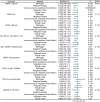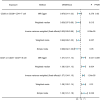Causal role of immune cells in generalized anxiety disorder: Mendelian randomization study
- PMID: 38264647
- PMCID: PMC10803460
- DOI: 10.3389/fimmu.2023.1338083
Causal role of immune cells in generalized anxiety disorder: Mendelian randomization study
Abstract
Background: Generalized anxiety disorder (GAD) is a prevalent emotional disorder that has received relatively little attention regarding its immunological basis. Recent years have seen the widespread use of high-density genetic markers such as SNPs or CNVs for genotyping, as well as the advancement of genome-wide association studies (GWAS) technologies, which have facilitated the understanding of immunological mechanisms underlying several major psychiatric disorders. Despite these advancements, the immunological basis of GAD remains poorly understood. In light of this, we aimed to explore the causal relationship between immune cells and the disease through a Mendelian randomization study.
Methods: The summary information for GAD (Ncase=4,666, Ncontrol=337,577) was obtained from the FinnGen dataset. Summary statistics for the characterization of 731 immune cells, including morphological parameters (MP=32), median fluorescence intensity (MFI=389), absolute cells (AC=118), and relative cells (RC=192), were derived from the GWAS catalog. The study involved both forward MR analysis, with immune cell traits as the exposure and GAD as the outcome, and reverse MR analysis, with GAD as the exposure and immune cell traits as the outcome. We performed extensive sensitivity analyses to confirm the robustness, heterogeneity, and potential multi-biological effects of the study results. Also, to control for false positive results during multiple hypothesis testing, we adopted a false discovery rate (FDR) to control for statistical bias due to multiple comparisons.
Results: After FDR correction, GAD had no statistically significant effect on immunophenotypes. Several phenotypes with unadjusted low P-values are worth mentioning, including decreased PB/PC levels on B cells(β=-0.289, 95%CI=0.044~0.194, P=0.002), reduced PB/PC AC in GAD patients (β=-0.270, 95% CI=0.77~0.92, P=0.000), and diminished PB/PC on lymphocytes (β=-0.315, 95% CI=0.77~0.93, P=0.001). GAD also exerted a causal effect on CD27 on IgD-CD38br (β=-0.155,95%CI=0.78~0.94,P=0.002), CD20-%B cell (β= -0.105,95% CI=0.77~0.94, P=0.002), IgD-CD38br%lymphocyte(β=-0.305, 95%CI=0.79~0.95, P=0.002), FSC-A level on granulocytes (β=0.200, 95%CI=0.75~0.91, P=8.35×10-5), and CD4RA on TD CD4+(β=-0.150, 95% CI=0.82~1.02, P=0.099). Furthermore, Two lymphocyte subsets were identified to be significantly associated with GAD risk: CD24+ CD27+ B cell (OR=1.066,95%CI=1.04~1.10,P=1.237×10-5),CD28+CD4+T cell (OR=0.927, 95%CI=0.89~0.96, P=8.085×10-5).
Conclusion: The study has shown the close association between immune cells and GAD through genetic methods, thereby offering direction for future clinical research.
Keywords: MR analysis; causal inference; generalized anxiety disorder; immunity; sensitivity.
Copyright © 2024 Ma, Zhao, Zhao and Qu.
Conflict of interest statement
The authors declare that the research was conducted in the absence of any commercial or financial relationships that could be construed as a potential conflict of interest.
Figures
References
-
- Kuang N, Liu Z, Yu G, Wu X, Becker B, Fan H, et al. . Neurodevelopmental risk and adaptation as a model for comorbidity among internalizing and externalizing disorders: genomics and cell-specific expression enriched morphometric study. BMC Med (2023) 21(1):291. doi: 10.1186/s12916-023-02920-9 - DOI - PMC - PubMed
Publication types
MeSH terms
LinkOut - more resources
Full Text Sources
Research Materials




